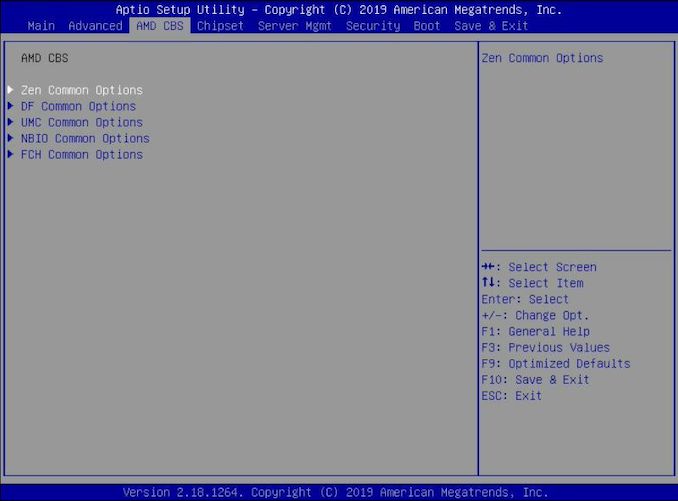The GIGABYTE MZ31-AR0 Motherboard Review: EPYC with Dual 10G
by Gavin Bonshor on March 25, 2020 1:15 PM ESTBIOS
The GIGABYTE MZ31-AR0 is using a basic version of its UEFI BIOS. This is designed for substance over style with its basic GUI which consists of a grey background, with blue text and white highlighting. As the firmware is so primitive, the firmware has no screenshot hotkey function, and we obtained the images through the Aspeed AST2500 remote management controller by logging in using a web browser.
Most of the options to control AMD EYPC processor functions such as global C-state control, downcore control, and power state relating settings can be found under the AMD CBS menu. For networking options, storage, and PCIe related options can be found in the Advanced section. The Aspeed AST2500 BMC functions and options can be found in the server management section with options for both BMC VLAN and BMC networking configuration.
The GIGABYTE MZ31-AR0 firmware is no-frills with professional users in mind. It includes an easy to use GUI and we found it stable to use. The firmware has plenty of professional-level BIOS functions, avoids any of the usual consumer-based desktop model fluff found on other models
Software
Users looking to access the Aspeed AST2500 BMC controller via a network can do so via the dedicated Gigabit Ethernet port on the rear panel. The baseboard management controller (BMC) can be accessed through the D-sub video output physically, or remotely through a dynamic or static IP address assigned to the AST2500 controller.
The GIGABYTE Server Management access panel has plenty for users to tuck into. Users can control the power status including remotely rebooting, powering up, or powering down provided the gigabit Ethernet port is physically connected to a network. There are options for monitoring the hardware itself, as well as accessing the system through a virtual media session using the KVM client which utilizes HTML5; this is limited to Mozilla Firefox, Google Chrome, and Microsoft's Internet Explorer. A GSM client can also be set up physically on a system which uses Java for its interface.
The GIGABYTE MZ31-AR0 doesn't include any form of media, and GSM will need to be downloaded directly from the official product page. Alternatively, users can log in through a web browser using the systems IP address for full control. The GSM utility works well with the board and provides all the usual functions expected from a server-grade motherboard.
























37 Comments
View All Comments
xyvyx2 - Wednesday, March 25, 2020 - link
physically the same, but not compatible :(https://en.wikipedia.org/wiki/Socket_sTRX4
Operandi - Wednesday, March 25, 2020 - link
Looks like the perfect board for my home Pfsense build. In all seriousness though looks like a pretty baller single socket Epyc board if only I had something lined up that could use it.Deicidium369 - Sunday, April 12, 2020 - link
a door stop would be an appropriate use for it - unlikely AMD would have the drivers ironed out.MenhirMike - Wednesday, March 25, 2020 - link
Does anyone know if it's possible to use Unbuffered ECC RAM with EPYC? Thinking of upgrading from a Threadripper to an EPYC for a Server, but I don't want to rebuy RAM as I already got enough DDR4 ECC UDIMMs.Slash3 - Wednesday, March 25, 2020 - link
Some Tyan boards seemingly support it from their spec sheets, but it's something that most reviews don't cover, unfortunately.Patrick at Serve the Home has also mentioned support on some older boards, but unfortunately he didn't mention any specific models in the one comment I was able to dig up on their forums.
MenhirMike - Wednesday, March 25, 2020 - link
Also, curious if the board supports bifurcation - the lack of M.2 Slots would make it perfect for e.g., an ASUS HYPER M.2 X16 or Supermicro AOC-SLG3-2M2 card, but for that it needs to support bifurcation of an x16 into 4x4 or an x8 into 2x4 slots.Slash3 - Wednesday, March 25, 2020 - link
The Hyper M.2 is long enough that you wouldn't be able to insert the card into the first five slots, which is a bit of a bummer. I can't confirm bifurcation support but I'd be very surprised if it didn't have it.phoenix_rizzen - Thursday, March 26, 2020 - link
We built our first iSCSI storage box around this motherboard. Have nothing but great experiences with it, and the IPMI implementation is light-years beyond what Supermicro supports (the GB IPMI is fully-web-enabled, using HTML5 KVM/console redirection, compared to the horrid Java implementation that Supermicro uses).The only downside if the SlimSAS connectors. It's very easy to find SlimSAS-to-SATA connectors (even comes with some in the box). Pain in the ass to find SlimSAS-to-SFF8084 connectors to connect to multi-lane, direct-attach backplanes! They exist, but nobody actually carries them (at least nobody that we could find in North America). Had to get them from a cable maker in China, which took the very slow boat to arrive.
For our first build, I messed up the model number for the backplane, ending up with an SAS expander version, so we had to use an HBA anyway.
For our second iSCSI storage server, we switched to the MZ01-CE0 motherboard. This includes 10GBase-T ports instead of SFP+. Other than that, it's virtually the same board. Got the right model backplane, and the SlimSAS-to-SFF8084 cables, giving 16 SATA connections direct off the motherboard.
For our next ZFS storage server, we'll be using MZ01-CE0 in a 2U chassis, running the OS off the motherboard connectors, with LSI/Broadcom/whoever-they-are-now HBAs with external connectors going to multiple 45-bay storage chasssis. That setup works great with all the extra PCIe lanes. :)
fazalmajid - Friday, March 27, 2020 - link
What OS do you use for your ZFS/iSCSI servers?phoenix_rizzen - Saturday, March 28, 2020 - link
FreeBSD